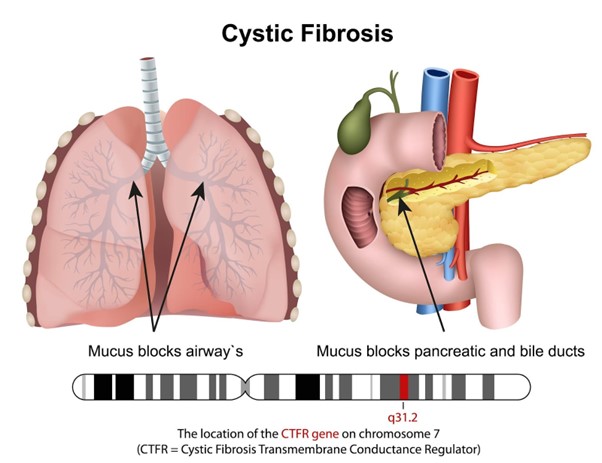A nurse is caring for an adolescent client who has cystic fibrosis. Which of the following actions should the nurse instruct the client to take prior to initiating postural drainage?
Complete oral hygiene.
Use an ibuterol inhaler.
Take pancrelipase.
Eat a meal.
The Correct Answer is B
The correct answer is B.
Choice A reason: Completing oral hygiene is important for overall health, especially for individuals with cystic fibrosis, as they are at a higher risk for dental problems due to thick mucus that can harbor bacteria. However, oral hygiene does not have a direct impact on the effectiveness of postural drainage. Postural drainage is a technique used to clear mucus from the lungs, and while maintaining oral hygiene is beneficial, it is not a prerequisite for this procedure.
Choice B reason: Using a bronchodilator, such as an ibuterol inhaler, is recommended before postural drainage because it helps to open the airways, making the procedure more effective. Bronchodilators work by relaxing the muscles around the airways, which can become constricted in conditions like cystic fibrosis. This relaxation allows for easier clearance of mucus during postural drainage.
Choice C reason: Pancrelipase is an enzyme supplement used to aid digestion in patients with cystic fibrosis, who often have pancreatic insufficiency. While taking pancrelipase is crucial for nutrient absorption, it is not specifically related to the respiratory treatment of postural drainage. Therefore, it is not necessary to take pancrelipase immediately before this procedure.
Choice D reason: Eating a meal before postural drainage is not recommended. The procedure involves placing the body in positions that facilitate the drainage of mucus from the lungs due to gravity. Having a full stomach can cause discomfort, increase the risk of vomiting, and may hinder the effectiveness of the drainage. It is best to perform postural drainage when the stomach is empty, either before meals or at least 1.5 hours after eating.

Nursing Test Bank
Naxlex Comprehensive Predictor Exams
Related Questions
Correct Answer is D
Explanation
A. BP 150/92 mm Hg:
- This blood pressure reading is elevated and not a therapeutic effect of magnesium sulfate. In the context of preeclampsia, the goal is usually to lower blood pressure to prevent complications.
B. Pulse rate 100/min:
- The pulse rate of 100/min is not a specific therapeutic effect of magnesium sulfate. However, magnesium sulfate may cause a decrease in heart rate, so monitoring for bradycardia would be important.
C. Flushed face:
- A flushed face is not a specific therapeutic effect of magnesium sulfate. Facial flushing may be associated with other factors, but it is not a primary consideration when monitoring the effectiveness of magnesium sulfate in the context of preeclampsia.
D. Negative clonus:
- Negative clonus is the correct therapeutic effect to monitor. Clonus refers to a series of involuntary, rhythmic, and repetitive muscle contractions and relaxations. In the context of magnesium sulfate administration for preeclampsia, negative clonus (the absence of abnormal reflexes) is a sign that the magnesium levels are within the therapeutic range, helping to prevent seizures.
Correct Answer is C
Explanation
Tell the client, “You seem to be very upset.”.
This is an example of a therapeutic communication technique that validates the client’s feelings and encourages them to express their emotions verbally rather than physically. It also shows empathy and respect for the client’s perspective.
Choice A is wrong because engaging the panic alarm is not the first action to take when interacting with an agitated client.
The nurse should first try to calm the client down by using verbal and nonverbal communication skills, such as maintaining eye contact, speaking in a calm and clear voice, and avoiding sudden movements or gestures.
Engaging the panic alarm should be done only if the client becomes violent or poses a threat to themselves or others.
Choice B is wrong because using a face shield with a mask when providing care to the client is not relevant to the situation.
This is a personal protective equipment (PPE) that is used to prevent exposure to infectious agents or body fluids, not to manage agitation.
Using a face shield with a mask may also increase the client’s anxiety or paranoia, as they may perceive it as a sign of hostility or fear.
Choice D is wrong because initiating seclusion protocol is not appropriate for a client who is agitated, pacing, and speaking loudly.
Seclusion is a restrictive intervention that involves isolating the client in a locked room to prevent harm to themselves or others.
It should be used only as a last resort when less restrictive measures have failed or are contraindicated, and only with a provider’s order and close monitoring.
Secluding an agitated client may escalate their behavior and violate their rights.
Normal ranges for agitation are not applicable, as agitation is not a quantifiable parameter.
However, some tools that can be used to assess agitation include the Richmond AgitationSedation Scale (RASS), which ranges from -5 (unarousable) to +4 (combative), and the Agitated Behavior Scale (ABS), which ranges from 14 (no agitation) to 56 (severe agitation).
Whether you are a student looking to ace your exams or a practicing nurse seeking to enhance your expertise , our nursing education contents will empower you with the confidence and competence to make a difference in the lives of patients and become a respected leader in the healthcare field.
Visit Naxlex, invest in your future and unlock endless possibilities with our unparalleled nursing education contents today
Report Wrong Answer on the Current Question
Do you disagree with the answer? If yes, what is your expected answer? Explain.
Kindly be descriptive with the issue you are facing.
